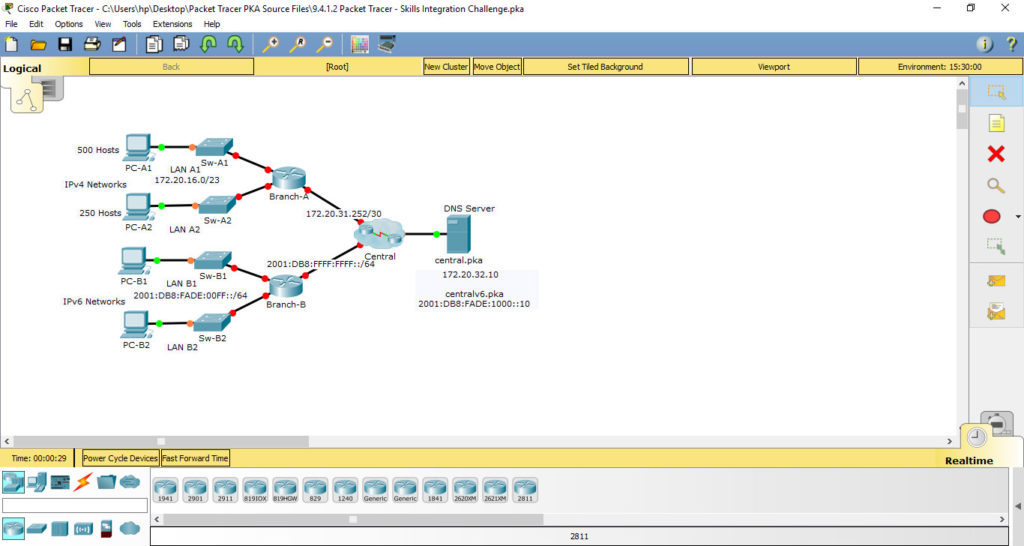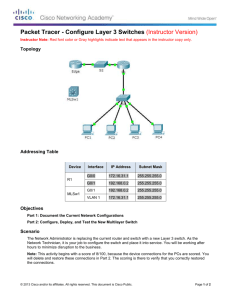
- #Ccna 2 packet tracer activity 9.4 2.8 script how to
- #Ccna 2 packet tracer activity 9.4 2.8 script Pc
#Ccna 2 packet tracer activity 9.4 2.8 script how to
CCNAv2 Custom Notes - How to Access your Control L.CCNAv2 Completed Packet Tracer 9.3.3.3 (CUSTOM).CCNAv2 Completed Packet Tracer 10.1.2.4.CCNAv2 Completed Packet Tracer 10.1.3.3.CCNAv2 Completed Packet Tracer 10.3.1.2.CCNAv2 Completed Packet Tracer 11.2.1.4.CCNAv2 Completed Packet Tracer 11.2.3.6.CCNAv2 Completed Packet Tracer 11.2.4.4.CCNAv2 Completed Packet Tracer 11.3.1.4.You might have used incorrect wildcards or applied the ACL incorrectly.

You should be 100% now, if not, check your steps and re-apply them. HQ(config-if)#ip access-group BranchServer in HQ(config)#ip access-list extended BranchServer Configure the access list on the appropriate router, apply it to the appropriate interface and in the appropriate direction.Ĭonfigure HQ to have an Access List for "BranchServer" and then apply it to g0/0. PT asks for as follows:ĭesign a named access list BranchServer to prevent any computers attached to the Gigabit Ethernet 0/0 interface of the HQ router from accessing the HTTP and HTTPS service of the Branch server. This is the same for HQ, so close out of Branch and go to HQ. Lets open the RT to create an extended Access List named "HQServer" (Case sensitive) that blocks all any host addresses from accessing HQServer, and allowing all other.īranch(config)#ip access-list extended HQServerīranch(config-ext-nacl)#deny ip any host 172.16.0.1īranch(config-ext-nacl)#permit ip any anyīranch(config-if)#ip access-group HQServer in The last thing we did on our Branch router was OSPF, which is fine. Configure the access list on the appropriate router, apply it to the appropriate interface and in the appropriate direction. PT asks for the following:ĭesign a named access list HQServer to prevent any computers attached to the Gigabit Ethernet 0/0 interface of the Branch router from accessing HQServer.pka. Lets open up Branch and configure our access lists. So, we have enough for HQ to be alive for now. HQ(config-router)#default-information originate

Set a default route on HQ which directs traffic to S0/0/1 interface.

HQ(config-router)#passive-interface S0/0/1 Note that HQ needs to be routed and configured. We can pause Branch configuration for now. Asking "Configure HQ and Branch with OSPF routing according to the following criteria" isn't too bad, it's just like our previous PTs with OSPF on them.īranch(config-router)#network 172.16.144.0 0.0.0.31 area 0īranch(config-router)#network 172.16.128.0 0.0.15.255 area 0īranch(config-router)#network 192.168.0.0 0.0.0.3 area 0īranch(config-router)#passive-interface g0/0īranch(config-router)#passive-interface g0/1 This means we have to make the networks be able to talk to each other. The PT asks us to configure the network's routers, such as Branch-RT. Do not advertise the link to the Internet.Ĭonfigure appropriate interfaces as passive.
#Ccna 2 packet tracer activity 9.4 2.8 script Pc
Document the addressing in the Addressing Table.Ĭonfigure the PC with the appropriate address.Ĭonfigure HQ and Branch with OSPF routing according to the following criteria:Īdvertise all three attached networks.

Start off with basic configuration and addressing assignment.īranch(config-if)#ip add 172.16.159.254 255.255.240.0īranch(config-if)#ip add 172.16.143.254 255.255.240.0Ĭonfigure B1 with appropriate addressing using the first available address of the network to which it is attached. Divide 172.16.128.0/19 into two equal subnets for use on Branch.ġ) Assign the last usable address of the second subnet to the Gigabit Ethernet 0/0 interface.Ģ) Assign the last usable address of the first subnet to the Gigabit Ethernet 0/1 interface.ģ) Document the addressing in the Addressing Table.Ĥ) Configure Branch with appropriate addressing


 0 kommentar(er)
0 kommentar(er)
